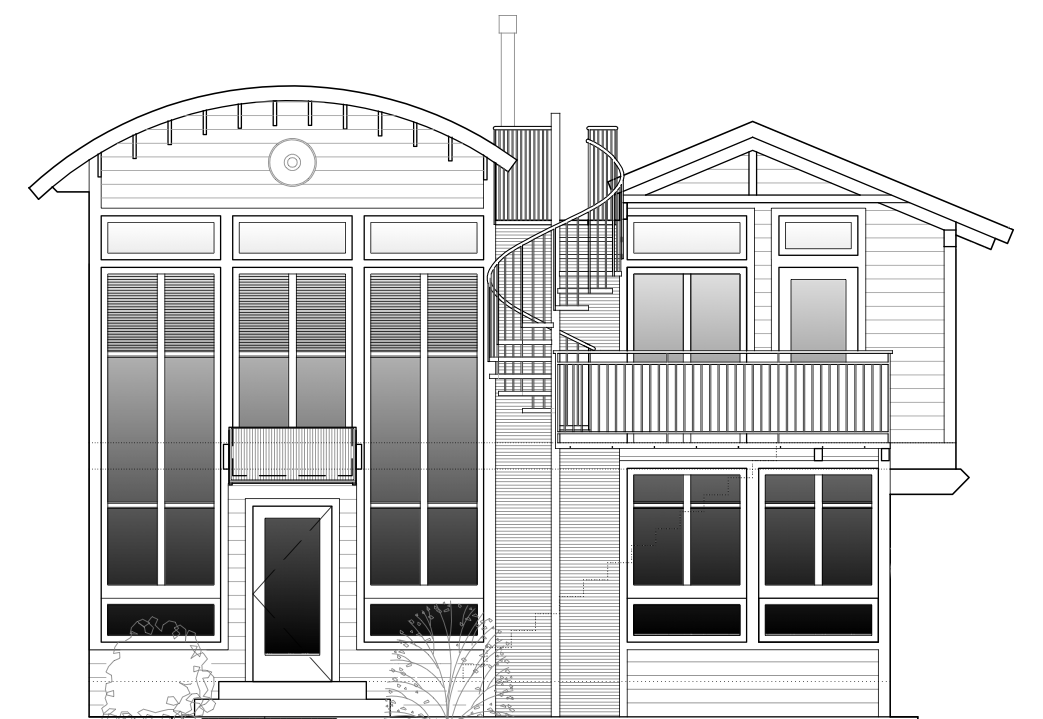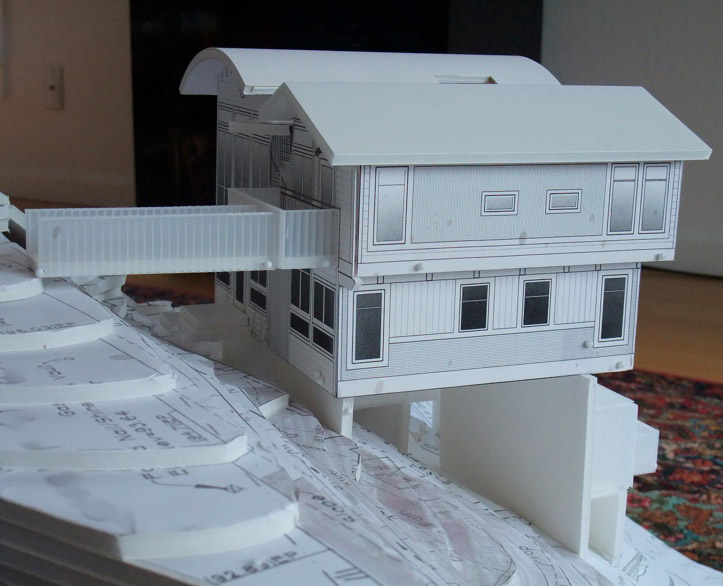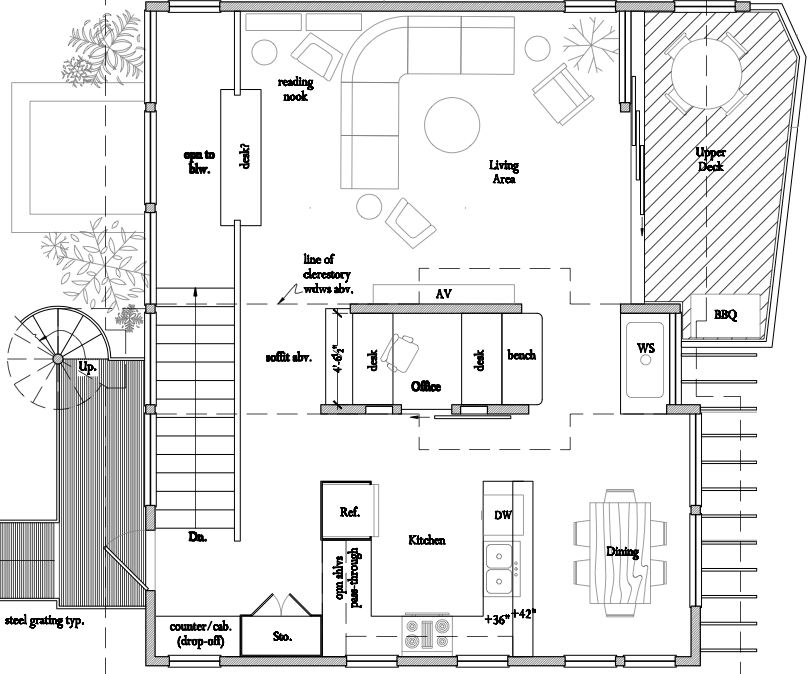|
SCRAPED! Anne & Lars Build a House |
|
Chapter 5: Design |
|
OMG plans at last! I thought about stringing you along a while longer, but faithful readers deserve better than that.
Let's recap the program: on a steep Sausalito lot with east-facing San Francisco Bay views and a road along the uphill side, we're building a two-bedroom house and an apartment, and four off-street parking spots. It took a few tries, but we finally got to a design that feels pretty good. Let's start with an artist's rendering, drawn from the architectural plans: 
Artist's rendering We commissioned this drawing to show the neighbors, and to submit with our design review application, for the same reason that it's the first thing you're seeing: it's a better introduction than the plans themselves. Plans require study. The house has a lot of parts that poke out here and there. Plans squash all those parts on top of one another, making them hard to absorb quickly. The drawing is a better basis for understanding the subsequent visuals. It gives you a conceptual head start. It also gives you an emotional head start. Plans and elevations are great for detail and precision, less so for setting context. They can't give a good sense of the surroundings, and they show abstract views that no one will actually see. They boil things down to idealized outlines. The effect can be somewhat formal, even sterile. To the people who will have a say in the outcome of this project, the first impression of the design should not be "Architecture", it should be a cottage in the woods, because that's what we are trying to build. Anyway, that's what the house will be like from from the highest corner of the property, where the street meets the public steps. (See site survey, upper left.) You can see the important streetside features of the house: two parallel rooflines -- a barrel vault and a ridged gable -- an elevated footbridge from the street, and a spiral stair leading to the roof. You can also see part of the lower story, which is mostly below street level. 
Front elevation The front elevation makes many details much clearer (although this early version is missing the footbridge). But you can see what I'm saying about the overall feeling. The house in the drawing nestles down into the slope among the trees. The house in the elevation reaches for the sky, formal and stately. It's the same house, but the elevation view is fictitious, unless you are a rock-burrowing creature with x-ray vision, coming to visit us by tunneling through the hill from the west. Human guests will use the street, which is level with the upper story. 
Site plan The site plan is another helpful orienting device, showing the footprint of the new structure. You can also see the positions of the footbridge and its landing, and the lower level entry. The dashed line shows construction setbacks. The street is at left. The site "points" east toward the bay at upper right. Downtown San Francisco is directly to the right -- the part of it that we can see, anyway. (And a splendid sight it is. I was there just after midnight this morning, watching the New Year's Day fireworks.) The new house is turned about 12 degrees clockwise with respect to the existing one. (See site survey.) This minimizes the earthworks needed to create the driveway, which starts at lower left, plunges down the hill, and ends up under the house between two parallel concrete walls, shown as dark gray strips. These are the house's foundation. There are three parking spots between these walls. In this view, one car straddles two front-to-back spots. (The other car is a first-generation Toyota MR2, one of which by coincidence I used to own.) The fourth parking spot is uphill, under the footbridge, between the west wall and the street. The dark gray T-shaped blob is the apartment footprint. It wraps around the east foundation wall, and has a landing off the public steps. We'll delve into that in a later blog entry. This one is already a whopper, and we've got a ways to go yet! 
From the driveway, looking northeast This model shot completes the street presence review. It is from the driveway entrance, and shows the house perched on its concrete foundation walls. You can also see an intriguing piece of the apartment below the house. I tease because I love. Now that you have the general idea, let's look at floor plans, top to bottom. I'll point out only the notable items. This is a blog post, not a construction bid package! But you can click on any picture for a bigger version. 
Roof level - roof deck Remember the spiral stairway that I so casually mentioned earlier? It leads to a little walkway between the roof volumes. The walkway widens into a small roof deck. It remains to be seen how much tree trimming we'll be able to do in order to open up views from within the house. But up here, the vista is sweeping and unobstructed. We'll put a couple of chairs up here (anchored against the wind) and watch the ships go by. The platform is slightly elevated for better viewing over its safety rail at the east end. The apparent stripes on the barrel vault are, in fact, stripes. They are formed using roll roofing in alternating strips of lightly contrasting colors. This emphasizes the curve of the barrel, for the benefit of anyone viewing from uphill -- including us, as we walk down the street from the highway bus stop. The gable roof is surfaced with corrugated weathering steel. That's a corrosion-resistant material used to make intermodal shipping containers. You should read up on those. 
Upper level - public rooms This is a so-called "upside-down" house, with public rooms above private rooms. We spend more time in the public rooms, so we want them to have the best views, which are less obstructed by trees the higher up we go. The upper level comprises a living room, kitchen, and dining room. The west end of the living room is open to the ground-level entry below. It is also all glass, which gives us a lot of late afternoon light. Much of this glass will likely be obscured for privacy from the street. South light enters the living room courtesy of a clerestory along the walkway above. The living room's east glass wall telescopes open, allowing wide access to the deck. In the center is a little chamber that defines and creates transitions between the two main spaces of the upper story. This is Anne's work pod. (In prior millenia, we would call this an "office".) It's an elevated cyber-cocoon with double desks. It can be closed off when it gets too messy, or opened up to the view. At the pod's eastern end is a bench that faces a fireplace across the hall. This fireplace can be seen by all the major areas of this floor. 
Lower level - private rooms The private level has two bathrooms and two bedrooms, with a walk-in closet and laundry area nearby. The master bedroom and bathroom get the bay views down here, but the guest room should be a nice little garden retreat with especially good afternoon light. In the summer, we expect the morning sun to be filtered through trees as it hits the shower. In winter, we'll probably get a direct unobstructed blast from the right. 
Rear view We complete the house tour with this model shot of the sides that you haven't seen yet. On the back side, we abandon all restraint as walls of glass let us bask in views of the bay. We look forward to it. There's so much more that could be said about the particulars of this design. It's mostly the work of our architect of course, but we managed to throw in some ideas of our own. There are a few substantial issues to work out, and innumerable details that we have yet to imagine. But this is the house we want to live in. Next time, we'll give the apartment its due. It's got a story all its own. |